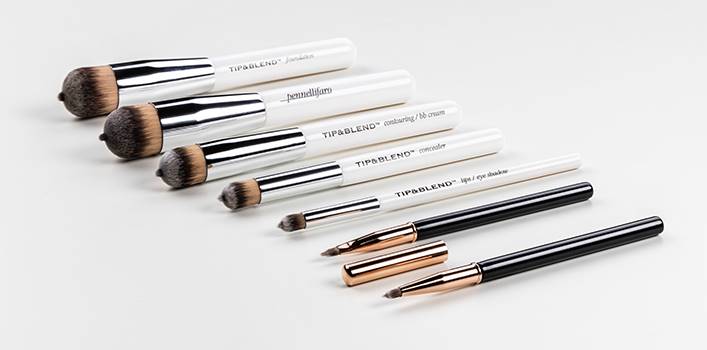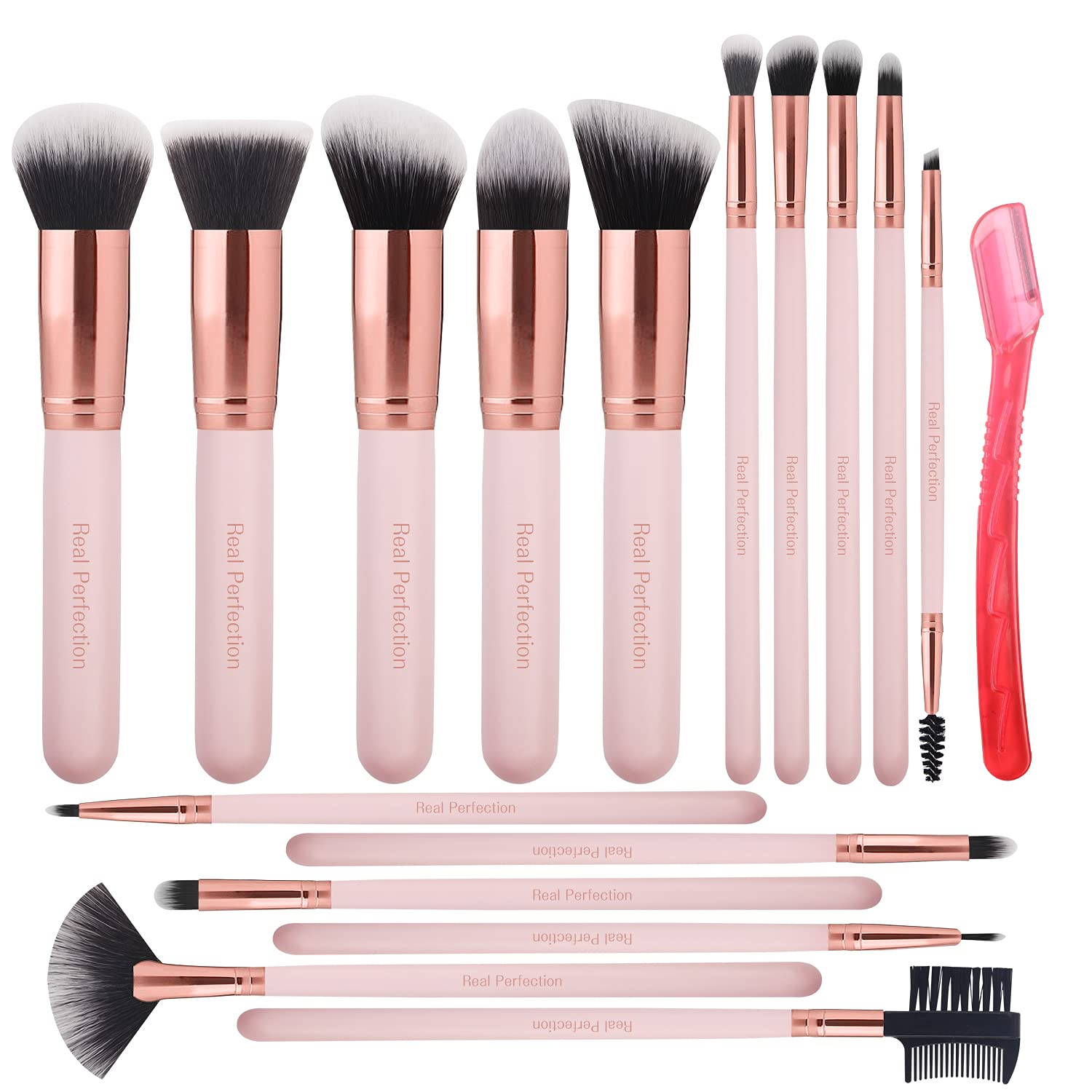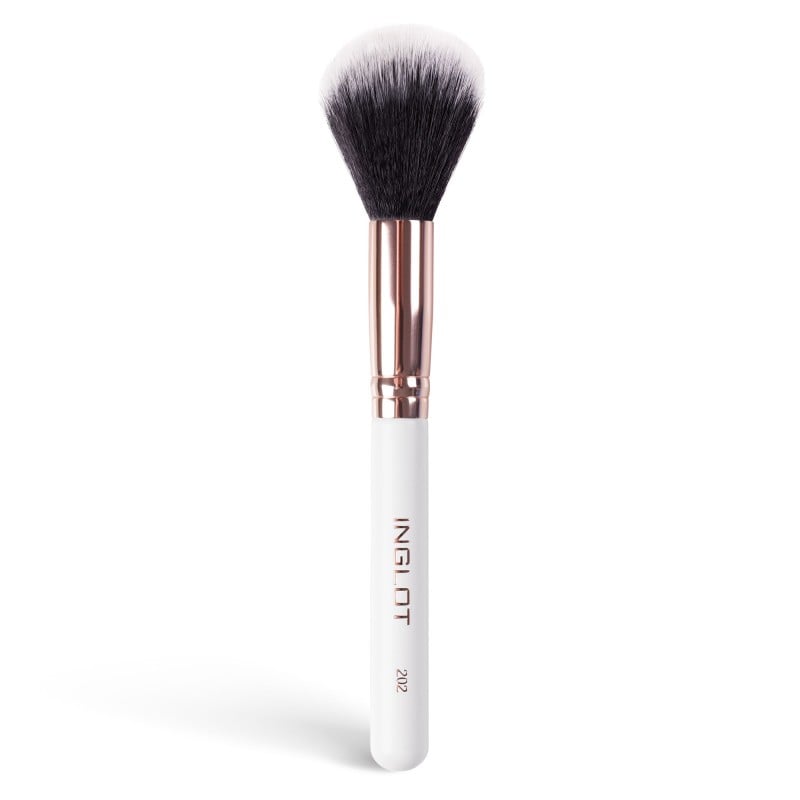
Makeup brushes are essential tools for applying cosmetics. They help achieve a flawless and professional look.
Makeup brushes come in various shapes and sizes, designed for specific tasks such as blending, contouring, and highlighting. Quality brushes enhance the application of makeup, ensuring a smooth and even finish. Synthetic and natural bristles offer different benefits, catering to various preferences and skin types.
Regular cleaning and proper maintenance extend the life of these tools, keeping them effective and hygienic. Investing in a good set of makeup brushes can elevate your beauty routine, providing better control and precision. Choose the right brushes for your needs to achieve stunning results and a polished appearance.
Types Of Brushes
Makeup brushes are essential tools for achieving a flawless look. They come in various types, each designed for specific tasks. Understanding the different types of brushes can help you create a beautiful makeup application.
Face Brushes
Face brushes are used to apply products on the face. Foundation brushes help to blend foundation smoothly. Powder brushes are fluffy and are perfect for applying loose or pressed powder. Blush brushes are angled to apply blush on the cheeks. Contour brushes help in defining the cheekbones and jawline. They are usually firm and angled.
| Brush Type | Use |
|---|---|
| Foundation Brush | Blends foundation |
| Powder Brush | Applies loose or pressed powder |
| Blush Brush | Applies blush |
| Contour Brush | Defines cheekbones and jawline |
Kabuki brushes are large and dense, perfect for buffing powders. Fan brushes are used for applying highlighter or sweeping away excess product. Each brush has a specific role, making your makeup look perfect.
Eye Brushes
Eye brushes are used for eye makeup. Eyeshadow brushes come in various sizes to apply and blend eyeshadow. Blending brushes are fluffy and help to soften harsh lines. Crease brushes are small and tapered for defining the crease. Eyeliner brushes are thin and used to apply eyeliner precisely.
- Eyeshadow Brush: Applies and blends eyeshadow.
- Blending Brush: Softens harsh lines.
- Crease Brush: Defines the crease.
- Eyeliner Brush: Applies eyeliner precisely.
Brow brushes are angled and help in filling and shaping eyebrows. Smudge brushes are small and stiff, used for smudging eyeliner or eyeshadow. Detail brushes are tiny and precise for intricate work. Eye brushes are crucial for a polished eye look.
Lip Brushes
Lip brushes help to apply lipstick or gloss with precision. Flat lip brushes are used to apply color evenly. They have a flat shape that covers the lips nicely. Pointed lip brushes are perfect for defining the lip line. They have a pointed tip for detailed work.
| Brush Type | Use |
|---|---|
| Flat Lip Brush | Applies color evenly |
| Pointed Lip Brush | Defines the lip line |
Retractable lip brushes are convenient for travel. They can be closed to keep the brush clean. Double-ended lip brushes have two sides, one for applying color and one for blending. Lip brushes ensure a precise and perfect lip application.
Also Read: How To Do Leg Makeup: Get Guide And Tips
Materials Used
Makeup brushes are essential tools for every makeup enthusiast. They help apply products smoothly and evenly. Understanding the materials used in makeup brushes is crucial. It impacts their performance and longevity. This blog post dives into the two primary materials used: natural hair and synthetic fibers.
Natural Hair
Natural hair makeup brushes are made from animal hair. These include squirrel, goat, and sable hair. They are popular for their soft texture and durability. Natural hair brushes excel in blending and applying powder products. They pick up more pigment and distribute it evenly. This results in a flawless finish.
Here are some common types of natural hair used in makeup brushes:
- Squirrel Hair: Extremely soft and fine. Best for light application.
- Goat Hair: Versatile and durable. Works well with various products.
- Sable Hair: Smooth and flexible. Ideal for detailed work.
Natural hair brushes are pricier than synthetic ones. But they offer superior performance and longevity. Proper care is essential to maintain their quality. Regular cleaning with mild soap keeps them in good shape.
Synthetic Fibers
Synthetic fiber brushes are made from man-made materials. These include nylon, polyester, and Taklon. They are a great option for liquid and cream products. Synthetic brushes do not absorb product. This makes them more hygienic and easier to clean. They are also cruelty-free and vegan-friendly.
Here are the benefits of synthetic fiber brushes:
- Easy to Clean: Synthetic fibers do not trap product.
- Less Shedding: They are more durable and shed less.
- Affordable: Generally cheaper than natural hair brushes.
Many modern synthetic brushes mimic the softness of natural hair. They are a great alternative for those who prefer not to use animal products. With advancements in technology, synthetic brushes offer excellent performance.
Read More: 9 Effective Glitter Makeup Tips To Sparkle Up Your Look
How To Choose The Right Makeup Brush
Choosing the right makeup brush can make a big difference in your beauty routine. Makeup brushes come in different shapes and sizes. Each one serves a unique purpose. The right brush can help you apply makeup smoothly and evenly. This blog will help you understand how to choose the perfect brush for your needs.
Skin Type Considerations
Different skin types need different brushes. Oily skin may benefit from synthetic brushes. These brushes are easy to clean and do not absorb oils. Dry skin might need softer brushes. Natural hair brushes can be a good choice. They are gentle and help spread makeup evenly. Here are some tips for different skin types:
- Oily Skin: Use synthetic brushes. Clean them often to avoid bacteria buildup.
- Dry Skin: Choose natural hair brushes. They are softer and kinder to the skin.
- Sensitive Skin: Look for hypoallergenic brushes. These brushes are gentle and safe.
Each skin type needs special care. Choose brushes that match your skin’s needs. This can help you achieve a flawless look.
Makeup Preferences
Your makeup style also affects your brush choice. If you love foundation, you might need a flat-top brush. This brush helps spread foundation evenly. For those who enjoy eye makeup, a variety of small brushes is useful. Blending brushes and eyeliner brushes are key. Here are some popular brush types:
- Foundation Brush: Flat-top or rounded brush for smooth foundation application.
- Blush Brush: Angled or dome-shaped brush for applying blush.
- Eyeshadow Brush: Small, flat brush for precise eye makeup.
- Blending Brush: Fluffy brush to blend eyeshadow colors.
- Eyeliner Brush: Thin, angled brush for applying eyeliner.
Matching your brushes to your makeup preferences can enhance your beauty routine. The right tools help you achieve the look you want with ease.

Credit: www.amazon.com
How To Clean Makeup Brush
Makeup brushes are essential tools for achieving flawless looks. Proper cleaning techniques ensure that your brushes last longer and stay effective. Keeping them clean also prevents skin issues caused by bacteria buildup. Let’s explore some effective cleaning techniques for your makeup brushes.
Daily Cleaning Tips
Daily cleaning of makeup brushes helps maintain their quality. Quick cleaning methods can be done easily.
- Use a gentle brush cleaner or makeup remover.
- Spray the cleaner directly onto the bristles.
- Wipe the brush on a clean tissue to remove makeup.
- Repeat the process until the brush is clean.
Daily cleaning ensures brushes are ready for the next use. It prevents makeup residue buildup.
Deep Cleaning Methods
Deep cleaning should be done weekly. This method removes all dirt and bacteria.
- Start by wetting the bristles with lukewarm water.
- Apply a gentle shampoo or brush cleaner.
- Swirl the brush in your palm to create lather.
- Rinse thoroughly with water.
- Gently squeeze out excess water.
- Reshape the bristles and lay the brush flat to dry.
Deep cleaning is crucial for maintaining brush hygiene. It ensures that your skin stays healthy.
Storage Solutions
Proper storage solutions for makeup brushes are essential for maintaining their quality and longevity. Well-organized brushes make the makeup application process more efficient and enjoyable. This blog post explores two popular storage options: brush holders and travel cases.
Brush Holders
Brush holders help keep your makeup brushes neatly organized and easily accessible. They come in various styles and materials, catering to different preferences and needs. Here are some popular types of brush holders:
- Cup Holders: Simple and functional, these holders keep brushes upright.
- Roll-Up Holders: Ideal for those with a larger collection of brushes.
- Acrylic Organizers: Transparent holders that provide a clear view of all brushes.
Acrylic organizers are particularly popular due to their sleek and modern design. They often feature multiple compartments, allowing for the separation of different brush types. Proper cleaning and maintenance of brush holders are crucial to prevent the buildup of makeup residue and bacteria.
Travel Cases
Travel cases are essential for makeup enthusiasts who are always on the go. These cases provide a safe and convenient way to carry makeup brushes while traveling. Here are some key features to look for in a good travel case:
- Durability: Choose cases made of strong materials to protect your brushes.
- Compartments: Multiple compartments help keep brushes separated and organized.
- Portability: Look for cases that are lightweight and easy to carry.
Many travel cases also come with additional storage for other makeup products. This feature is especially useful for those who prefer to keep all their makeup essentials in one place.

Brush Maintenance
Makeup brushes are essential tools for any makeup lover. They help to apply products evenly and create flawless looks. Brush maintenance is key to keeping them in great condition and prolonging their lifespan. Regular cleaning and proper storage can make a significant difference. This guide will help you understand the best practices for taking care of your makeup brushes.
Proper Handling
Handling your makeup brushes correctly is crucial to their longevity. Here are some tips to ensure you are taking good care of them:
- Always hold the brush by the handle. This keeps the bristles from getting damaged.
- Avoid pressing too hard on the brush. Gentle strokes work best for makeup application.
- Keep brushes away from extreme temperatures. Heat can weaken the glue that holds the bristles.
- Store brushes in a clean, dry place. Avoid leaving them in damp areas like the bathroom.
Cleaning brushes regularly is also part of proper handling:
- Use a gentle brush cleaner or mild soap.
- Rinse thoroughly with lukewarm water.
- Pat dry with a clean towel and reshape the bristles.
- Lay brushes flat to dry. Do not stand them upright, as water can seep into the handle.
Longevity Tips
There are several tips to ensure your makeup brushes last a long time:
- Invest in quality brushes. They may cost more, but they last longer and perform better.
- Rotate between brushes. Using the same brush every day can wear it out faster.
- Avoid overloading brushes with product. Excess product can get trapped in the bristles and be hard to clean out.
- Use brush guards. These help maintain the shape of the bristles and prevent fraying.
Regularly inspect your brushes for signs of wear and tear:
- Check for loose bristles.
- Look at the handle for cracks or splits.
- Ensure the ferrule (the metal part) is secure.
By following these tips, you can make sure your makeup brushes stay in excellent condition. Well-maintained brushes not only perform better but also save you money in the long run.
Application Techniques
Makeup brushes are essential tools for achieving a flawless look. Different brushes serve different purposes. Knowing the right application techniques can make a big difference. Two popular techniques are stippling and buffing.
Stippling
Stippling is a technique that provides an airbrushed finish. It uses a special brush called a stippling brush. This brush has two types of bristles, short and long. The short bristles hold the makeup, and the long ones blend it. Stippling is great for applying foundation and blush. It creates a smooth, even look.
The steps to stippling are simple:
- Dip the brush lightly into the product.
- Tap off any excess makeup.
- Gently press the brush onto your skin.
- Use a light, dabbing motion.
- Blend the makeup by swirling the brush lightly.
Stippling works well for all skin types. It gives a natural, dewy finish. This technique helps to cover imperfections without looking heavy.
Buffing
Buffing involves using a dense, fluffy brush. This technique blends makeup into the skin. Buffing is perfect for powders, foundations, and bronzers. It creates a seamless, polished look.
The steps to buffing include:
- Load the brush with the product.
- Tap off any excess powder.
- Use circular motions to apply the makeup.
- Work the product into the skin.
- Blend well to avoid lines or streaks.
Buffing offers a more natural finish. It is ideal for everyday makeup. This technique is quick and easy. Buffing also helps to build coverage without caking.
Makeup Brush Trend In 2025
Makeup brushes have become essential tools in every beauty enthusiast’s kit. Trends in makeup brushes have evolved, bringing in innovative designs and eco-friendly options. These trends not only enhance makeup application but also cater to the growing awareness of sustainability. Let’s dive into the latest trends in makeup brushes.
Innovative Designs
Brush manufacturers are constantly pushing the boundaries of design. They create brushes that provide better grip and control. Ergonomic handles are one such innovation, reducing strain during application.
Multi-functional brushes are becoming popular. These brushes serve multiple purposes, reducing the need for multiple tools. For example:
- Double-ended brushes with different heads.
- Retractable brushes for easy storage.
- Interchangeable heads for various applications.
Another trend is the use of synthetic bristles that mimic natural hair. These bristles are softer and more durable. They also work well with various types of makeup, from powders to creams.
Silicone brushes are making waves too. They are easy to clean and perfect for applying liquid products. Vibrating brushes are another innovative design. They ensure even application and a flawless finish.
Eco-friendly Options
Sustainability is becoming a key focus in the beauty industry. Eco-friendly makeup brushes are gaining popularity. These brushes are made from sustainable materials like bamboo and recycled plastics.
Bamboo handles are not only eco-friendly but also lightweight and durable. Recycled materials are used for the bristles and handles, reducing waste. Some brands use biodegradable packaging to further their commitment to the environment.
Cruelty-free brushes are another important trend. These brushes do not use animal hair, making them a better choice for ethical consumers. Vegan bristles are made from synthetic fibers, providing the same quality without harming animals.
Here is a comparison table of popular eco-friendly materials:
| Material | Benefits |
|---|---|
| Bamboo | Lightweight, durable, sustainable |
| Recycled Plastic | Reduces waste, eco-friendly |
| Synthetic Fibers | Cruelty-free, durable, high quality |
Eco-friendly options are not just a trend but a necessity. They help reduce the environmental impact of the beauty industry. Choosing these brushes supports sustainable practices and a healthier planet.

Credit: inglotusa.com
Frequently Asked Questions
What Are The Types Of Makeup Brushes?
Makeup brushes come in various types, including foundation, blush, eyeshadow, and contour brushes. Each type is designed for specific applications.
How Do I Clean Makeup Brushes?
Clean brushes with gentle soap and lukewarm water. Rinse thoroughly and let them dry completely. Regular cleaning prevents bacteria buildup.
How Often Should I Replace Makeup Brushes?
Replace makeup brushes every 6-12 months. Frequent use and improper cleaning can wear them out quicker.
Why Use Synthetic Makeup Brushes?
Synthetic brushes are cruelty-free and work well with liquid products. They are also easier to clean and maintain.
Conclusion
Choosing the right makeup brushes can transform your beauty routine. Quality brushes ensure flawless application and longevity. Invest in brushes that suit your needs. Clean them regularly to maintain hygiene and performance. With the right tools, achieving professional makeup looks becomes effortless.
Enhance your beauty routine by selecting the best makeup brushes.









